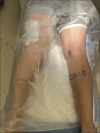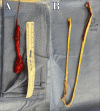Distal Hamstring Injuries and Disorders
- PMID: 40972536
- PMCID: PMC12445417
- DOI: 10.5435/JAAOSGlobal-D-25-00248
Distal Hamstring Injuries and Disorders
Abstract
Hamstring injuries are a common injury sustained by athletes with most injuries occurring as strain injuries within the muscle belly or at the proximal musculotendinous junction. Distal hamstring pathology is relatively uncommon but comprises a collection of both acute and chronic diagnoses that can manifest with symptoms either on the medial or lateral side of the knee based on which hamstring tendons are involved. Pes anserinus bursitis is the most common of these distal hamstring pathologies with other chronic diagnoses, including snapping medial hamstrings or snapping biceps femoris. Acute biceps femoris ruptures can occur in an isolated fashion but most often occur in the setting of concomitant posterolateral corner injury as a result of high-energy trauma. Isolated semitendinosus ruptures can occur with lower-energy acute events, commonly with track and field events. Most distal hamstring pathology can be treated without surgery and do well with conservative treatment. However, acute avulsion injuries often require surgical intervention, as can chronic problems that do not adequately respond to prolonged conservative treatment. Treatment algorithms for distal hamstring injuries are less well-developed than more proximal injuries owing to their lower incidence. This review focuses on distal hamstring injuries, the state of current literature, and treatment strategies.
Copyright © 2025 The Authors. Published by Wolters Kluwer Health, Inc. on behalf of the American Academy of Orthopaedic Surgeons.
Figures





References
-
- Ahmad CS, Redler LH, Ciccotti MG, Maffulli N, Longo UG, Bradley J: Evaluation and management of hamstring injuries. Am J Sports Med 2013;41:2933-2947. - PubMed
-
- Ali K, Leland JM: Hamstring strains and tears in the athlete. Clin Sports Med 2012;31:263-272. - PubMed
-
- Arner JW, McClincy MP, Bradley JP: Hamstring injuries in athletes: Evidence-based treatment. J Am Acad Orthop Surg 2019;27:868-877. - PubMed
-
- Clanton TO, Coupe KJ: Hamstring strains in athletes: Diagnosis and treatment. J Am Acad Orthop Surg 1998;6:237-248. - PubMed
Publication types
MeSH terms
LinkOut - more resources
Full Text Sources
Medical

